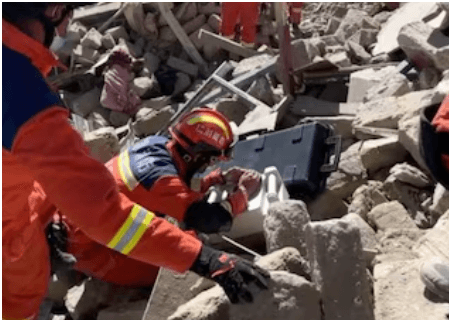
Southwest Research Institute advancing robotics tech
[ad_1]
On a recent afternoon, Paul Evans stands beside a small blue and gray robotic arm. Inside the collaborative robotics laboratory on Southwest Research Institute’s sprawling West Side campus, the technology next to him offers a notable advancement in automated appendages: It can detect when it comes into contact with something — or someone — else and stop immediately.
The arm is “force and torque limited,” said Evans, director of SwRI’s manufacturing and robotics technologies department.
“When it hits something, it faults out and stops,” he said.
Large, fast-moving industrial robots are usually kept in cages on work sites, under tight restrictions to ensure they don’t hurt or even kill people who are moving through the space. The collaborative robot in SwRI’s lab is a model of a lightweight “cobot” — made without sharp edges and pinch points — that’s becoming popular in automation.
In the new era of robotics, cobots are meant to work side by side with people, and SwRI engineers are seeking to advance the technology.
“Let’s say I’m a robot and I’m doing something here and a human comes into the workspace,” Evans said. “The robot should know that it should be able to go around, but it doesn’t have that intelligence. We’re working on sensors and cameras to watch or monitor humans and robots in the workspace to know where they are and send commands through programming for the robot to replan its path instead of hitting the human.”
SwRI has nearly 100 electrical, mechanical and software engineers working to solve robotic challenges for a variety of industries, including manufacturing, automotive, aerospace, health care, space science, and mechanical and chemical engineering. Evans leads a 35-member team of engineers — focused on industrial automation and custom robotic designs — that has influenced developments and programs for autonomous vehicles and drones, as well as several technologies not directly related to autonomous operation.
Meanwhile, SwRI and Evans, in particular, have had a profound influence in fostering a budding hub of robotics innovators and innovating young companies in San Antonio.
Besides having a reputation among local tech leaders as being on the forefront of the robotics industry, Evans is associated with a nonprofit making a name for itself as a hotbed for building talent and creating companies at a time when roboticists in the city are aiming for a seat among colleagues in the industry’s Big Three hubs — Boston, Pittsburgh and Silicon Valley.
Early days in SwRI robotics
The history of robotics in San Antonio, in many ways, is rooted in SwRI’s history.
The nonprofit contract research organization was founded in 1947 on a converted cattle ranch, where researchers spent the next two decades focusing on automotive testing, radio direction finding and the environment. In the 1970s and 1980s, SwRI expanded its research into space, oil and gas, ocean engineering and robotics amid high interest among U.S. manufacturers.
In the mid-1980s, researchers used the large, hydraulic Cincinnati Milacron, one of the first robots here, in an early-stage mobile manipulator for de-riveting aerospace components. The industrial robot had incredible power, but it could rip up the concrete floors if it ever crashed.
By the early 1990s, researchers were looking to electric motor-controlled robots and bought a Puma 760 for some of their first vision-guided industrial applications, such as polishing aircraft parts. They also built some of the largest robots in the world designed to remove humans from dirty and dangerous work environments. The series of “Big Orange Robots,” for example, were built for F-15 and F-16 aircraft coating removal.
That was when “computational power was a challenge” and camera technology was low-res, Evans said, resulting in robots being unable to perform “complex machine vision” tasks.
“But even in those early days, Southwest Research Institute was pushing the envelope of what was possible,” he said, “and we were blazing the trail relative to industry needs that still remain of interest today.”
The engineer
Evans, 50, credits his grandfathers for his affinity for science. His maternal grandfather was a pilot for the U.S. Air Force and for airlines, while his paternal grandfather was a technician supporting utilities for a Navy base.
“I inherited their own interests in engineering and technology that inspired me to become a roboticist,” said Evans, who was born in Tennessee and raised in Alabama and near Des Moines, Iowa.
In 1993, he enrolled at Walla Walla University in Washington state as a premed major. But after a few biology classes, he got bored and switched to engineering. He liked figuring out how things worked and quickly found joy in his first robotics course.
After earning his bachelor’s degree, he attended Iowa State University in 1995, where he initially studied mechanical engineering before drastically switching gears to focus on virtual reality. He went on to build virtual environments and scenarios for industrial applications.
His first job in the lab there involved a Ford-sponsored program “to optimize noise vibration and harshness for the automotive industry,” he said. He also worked on designing virtual mechanisms in a 3D virtual environment versus trying to sketch things on paper or using 2D computer-aided design tools.
Evans didn’t realize at the time that the graphics programming and software development skills he was honing in that lab would help him succeed in robotics.
“A lot of the matrix, linear algebra concepts and scaling and transformations … have a lot of similar concepts similar to motion-control and robotics systems,” he said.
In 1997, he interviewed for two jobs at SwRI, one in automotive research and one in the robotics and automotive area. He took the second position and has been there ever since.
“I came over here and looked through this building and saw cool machines and robots in action,” he said. “I just knew that’s what I wanted.”
Continuing on cutting edge
In the manufacturing and robotics technologies department, Evans greets casually dressed co-workers working on various projects. To the right is the Yaskawa Motoman MH180-120, a blue, noncollaborative industrial robot over 10 feet tall. To the left is the Advanced Mobility Crawler prototype, capable of moving through and inspecting confined spaces such as pipes, storage tanks and fluid transportation tankers.
During Evans’ early years at SwRI, the staff was creating and installing large-scale depainting systems for the military to check for signs of corrosion and other damage on fighter aircraft, such as the F-15 Eagle and the F-16 Falcon. The depainting process is labor-intensive, highly repetitive and physically demanding.
By 2009, SwRI engineers began thinking about building larger, faster and cleaner robots that can move between hangars instead of being fixed in one location. That notion led them into the world of large-scale, laser-wielding, mobile robots.
In 2020, SwRI finished building the laser coating removal robot, a 45-foot-tall, 20-ton robot with a 20-kilowatt laser. It’s the largest of its kind and the only one known to fast-track all aircraft coatings on a broad range of defense and commercial aircraft, from fighter-size jets to cargo-size air frames.
More recently, SwRI engineers have been working on robotic projects related to nuclear energy.
In 2020, the nonprofit was awarded $1.3 million in work from a U.S. Department of Energy contractor to build a robotic system for inspecting the bottom of massive underground tanks at the decommissioned nuclear production complex known as the Hanford Site in Washington state. The tanks each store 56 million gallons of chemical and radioactive waste.
Last year, SwRI showcased a drone during the EnRicH 2021 European Robotics Hackathon to explore and map the inside of the Zwentendorf Nuclear Power Plant in Austria.
In June, it introduced new automation technology that enables robots using machine learning algorithms and classification software to scan industrial parts and get to work. The technology can grind, paint, polish, clean, weld and seal, representing a paradigm shift in the field — developing robots that can perform multiple tasks in an industrial setting.
SwRI’s robotics family tree
Current and former SwRI engineers are part of what many consider an evolving world-class robotic innovation cluster.
At Port San Antonio on the Southwest Side, a 15-minute-drive from SwRI, the Tech Port Center + Arena opened its doors to SATX Robotix, a community of technologists working on autonomous vehicles, drones and industrial robots who meet to network and present the freshest technology in their fields.
They gathered recently to celebrate news that San Antonio has been recognized by the U.S. Alliance of Robotics Clusters, a group of nonprofits and organizations based in the nation’s largest robotics hubs. The alliance invited San Antonio-based robotics startups to co-exhibit at the International Manufacturing Technology Show in September in Chicago. It’s the nation’s largest manufacturing and automation expo.
“We’re elevating our profile and doing something with the Big Three, which has always been the mission of our group,” Stephanie Garcia, a business development specialist at Port San Antonio who organizes events for SATX Robotix, told the crowd. “This is not Austin that was invited. This was San Antonio.”
“I think we can show everybody that we are Robo City USA,” she said to applause.
Several of those applauding credit SwRI and Evans, who was also in attendance, for seeding a growing family tree of robotics in San Antonio. They include SwRI alumni Shaun Edwards, co-founder and chief technology officer of Plus One Robotics; Michael Blanton, CTO at Renu Robotics; and Kris Kozak, co-founder of Hatchbed, all privately owned San Antonio-based companies
After the meetup, Edwards recalled his time as a principal research engineer at SwRI in 2011, when he co-founded the robot operating system program known as “ROS-Industrial” — an open-source software for research that advances robotics in manufacturing and industry.
SwRI has since used ROS-Industrial to develop automation robots for various tasks that include sanding, painting, grinding, food processing, inspecting, ink jet printing and bin picking.
“My founding of ROS-Industrial doesn’t happen without Paul Evans’ leadership,” Edwards said in an email.
As Edwards told it, Evans allowed him to take a six-month sabbatical to live in Silicon Valley and focus on open-source software at Willow Garage, then a robotics research lab run by several creators of the Google Search Engine.
“ROS-Industrial was the culmination of that work at Willow,” he wrote. “I can only imagine the pushback (Evans) would have received from his leadership, to allow a senior engineer the opportunity to work at another company and ultimately release a bunch of open-source software. I would say that such an opportunity is not possible at most places. Paul deserves a lot of credit for making it happen.”
Over the years, Evans has recruited and managed many future leaders in robotics, including Paul Hvass, co-founder and chief security officer at Plus One Robotics; and Crystal Parrot, the chief operating officer at Plus One Robotics.
Blanton at Renu Robotics, also a former research engineer at SwRI, worked with Evans for almost a decade.
“The reputation that SwRI brings to, and maintains for, the robotics community in San Antonio can’t be understated,” Blanton said in an email, noting that Evans has helped design some of the largest robotic systems in the world. “Paul is a driving force of the efforts at SwRI to bring cutting-edge robotics capabilities to the world.”
Some former SwRI roboticists have taken their talents beyond San Antonio, including Levi Armstrong, a staff engineer at Tortuga AgTech in Kerrville. Beyond Texas, there’s Rob Johanneson, owner of Endpoint Solutions in Pennsylvania, and Clay Flannigan, senior manager at Amazon Robotics, based in the Boston area
“While I’m sure Evans would rather that team remained at SwRI,” Edwards said, “he should be very proud of the fact that former-SwRI carries a lot of weight in robotics circles.”
At Hatchbed, five of its staffers worked for SwRI, said Kozak, who’s known Evans for more than a decade.
“SwRI has bright experts, scientists, some of whom left to start companies and stay in the community to advance the city as a whole,” he said. “Their fingerprints are all over the place.”
eric.killelea@express-news.net
[ad_2]
Source link







